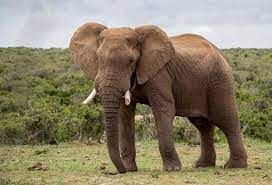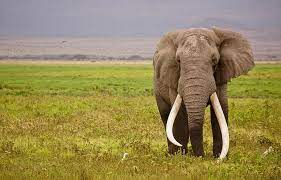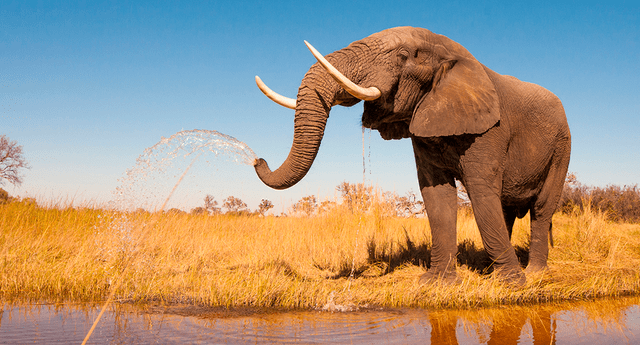Did you know that the elephant is an animal that is grouped in matriarchal families? Here we tell you more about Elephant Behavioral Adaptations.The elephant is one of the largest mammals that exists in the world and, in the terrestrial sphere, it undoubtedly takes the first place. It is, neither more nor less, a species descended from mammoths and mastodons: the colossi of the Ice Age.

Elephant Behavioral Adaptations
- This large animal is very social and lives in herds. To communicate with each other they use the sounds produced by the trunk, and are able to express different emotions . The use of the prominent nose is to show fear or to signal imminent danger. In this way the elephant warns its family, which is composed mainly of female and young specimens, and some adult males, as a real military company.
- With one difference, however: the males, in fact, live alone until the moment of mating . In that period they get closer to the herd.When a specimen is too old or feels bad, all the other members of the group settle around him to accompany him in the last days of his life. African elephants are highly intelligent and have impressive brains.
- To survive, the elephant does not need to flee , since it has no predators . The greatest enemy for this species, without a doubt, is man. For centuries it has been hunted indiscriminately, either to extract its ivory tusks, to use it as a means of transportation, or to exploit it, making money in circuses and zoos .
- If its hunting is banned, the black market and poaching, however, continue. If we add to this that pregnancies are very long and that elephants have only one cub at a time, it is easy to see why the elephant is now in danger of extinction .
- The good news is that a female can give birth up to the age of 50 and have a puppy every 3 years in a natural state. Furthermore, this species is one of the most long-lived, since a healthy, adult specimen can easily reach 80 years of life.
Once they die, elephants display various behaviors, such as:
Raise the trunk while standing, in a posture that denotes tension.
Caress the corpse with the trunk, as well as throw dirt, leaves or branches on the remains.
Stay with the corpse until the rotting process begins.
Elephants can adapt to different climates and ecosystems. Although they are often seen in African grasslands, they can also live in forests or savannas. They need a nearby water source for drinking and even bathing to reduce the heat.
Elephant Behavioral Adaptations You Must Know.

- Despite being very large, the elephant is herbivorous and its diet is based on grass, fruit, tree bark, plants and small bushes. You can eat up to 250 kg of food per day . From birth up to 2 years, the offspring feeds only on mother ‘s milk . They spend no less than 16 hours each day feeding, because their body can only process 50% of what they eat. And another fact: an elephant can drink up to 15 liters of water at a time.
-
- They are bulky animals, whose bodies can measure about 4 meters high and several tons in weight (on average, about 7,500 kg). Its brain, the largest of all land animals, weighs only 5 kg, and gives the elephant an intelligence comparable to a cetacean or some primates.
- Its trunk, the best-known feature of the species, has thousands of muscles (40,000 or 100,000 depending on the different sources) and is a sensitive extension of the nose, capable of perceiving an immense range of distant smells (elephants have the best sense of smell of all species), picking up food from the ground, sniffing and pouring water into their mouths or on their bodies to cool themselves, or emitting sounds of various ranges, including infrasonic sounds.
- At the same time, they have enormous ears , which allow them a keen sense of hearing . On the other hand, they have poor vision , with their eyes on the sides of the head, which makes them particularly sensitive to sudden and sudden movements, to which they tend to respond aggressively.
- The males of the species have two gigantic ivory tusks , an extension of their incisor teeth, which protrude from their upper jaw and that these animals use to make their way through the bush, dig in the ground, mark their territory or attack and defend themselves, in if necessary. Ivory compounds have been highly valued throughout history and are one reason why they have been so extensively hunted.
- Their skin is thick and wrinkled , grayish or brownish in color, and they have sparse, sparse fur. To avoid dehydration, they usually spend a lot of time in the water , and cover themselves with a film of mud to protect them from sunlight.
- Traditionally they are credited with a good memory , which appears to be true, and they are known to have rich social interaction, with abundant gestures of empathy , compassion, play , primitive use of tools, and self-recognition.
- It is also said that they fear mice (which is totally false), and that they constitute their own cemeteries. The latter may be a misinterpretation of the fact that dying elephants instinctively seek water, which is why they tend to leave their bodies in similar regions. However, elephants have been seen to recognize the remains of their species among those of others , and play with them as if paying them some kind of tribute.
